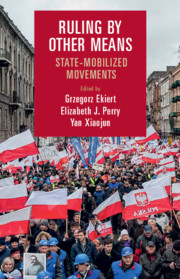Book contents
- Ruling by Other Means
- Cambridge Studies in Contentious Politics
- Ruling by Other Means
- Copyright page
- Contents
- Figures
- Tables
- Contributors
- Acknowledgments
- 1 State-Mobilized Movements: A Research Agenda
- 2 Manufactured Ambiguity
- 3 Suppressing Students in the People’s Republic of China
- 4 State-Mobilized Community Development
- 5 Enforcement Networks and Racial Contention in Civil Rights–Era Mississippi
- 6 Social Sources of Counterrevolution
- 7 Occupy Youth!
- 8 State-Mobilized Movements after Annexation of Crimea
- 9 Mirroring Opposition Threats
- 10 Mobilizing against Change
- 11 The Dynamics of State-Mobilized Movements
- 12 State-Mobilized Campaign and the Prodemocracy Movement in Hong Kong, 2013–2015
- 13 The Resurrection of Lei Feng
- Index
- Books in the Series (continued from p.iii)
- References
7 - Occupy Youth!
State-Mobilized Movements in the Putin Era (or, What Was Nashi and What Comes Next?)
Published online by Cambridge University Press: 29 July 2020
- Ruling by Other Means
- Cambridge Studies in Contentious Politics
- Ruling by Other Means
- Copyright page
- Contents
- Figures
- Tables
- Contributors
- Acknowledgments
- 1 State-Mobilized Movements: A Research Agenda
- 2 Manufactured Ambiguity
- 3 Suppressing Students in the People’s Republic of China
- 4 State-Mobilized Community Development
- 5 Enforcement Networks and Racial Contention in Civil Rights–Era Mississippi
- 6 Social Sources of Counterrevolution
- 7 Occupy Youth!
- 8 State-Mobilized Movements after Annexation of Crimea
- 9 Mirroring Opposition Threats
- 10 Mobilizing against Change
- 11 The Dynamics of State-Mobilized Movements
- 12 State-Mobilized Campaign and the Prodemocracy Movement in Hong Kong, 2013–2015
- 13 The Resurrection of Lei Feng
- Index
- Books in the Series (continued from p.iii)
- References
Summary
One frigid December morning, I struggled out of bed at 5 am to join several hundred local youth at the Tver’ railway station. I was joining a campaign organized by the pro-Kremlin youth movement Nashi (Ours). We were traveling to Moscow to meet with World War II veterans, bearing gifts and best wishes for the New Year. Our train was one of many traveling from the provinces to Moscow that morning. Kirill, my Nashi activist contact (a “komissar” in the movement who had participated in our research project), explained that the campaign, entitled “A Holiday Returned,” was timed to coincide with the sixty-fifth anniversary of the Battle of Moscow – to give back to surviving veterans the New Year’s holiday celebration that had been cruelly snatched from them by the Nazis during the winter of 1941. Kirill had explained that the campaign would bring 100,000 young people from across the Russian Federation to the capital in specially commissioned trains. Each group of 100 was to meet with a group of veterans and present them with a New Year’s gift.
- Type
- Chapter
- Information
- Ruling by Other MeansState-Mobilized Movements, pp. 166 - 192Publisher: Cambridge University PressPrint publication year: 2020
References
- 1
- Cited by



